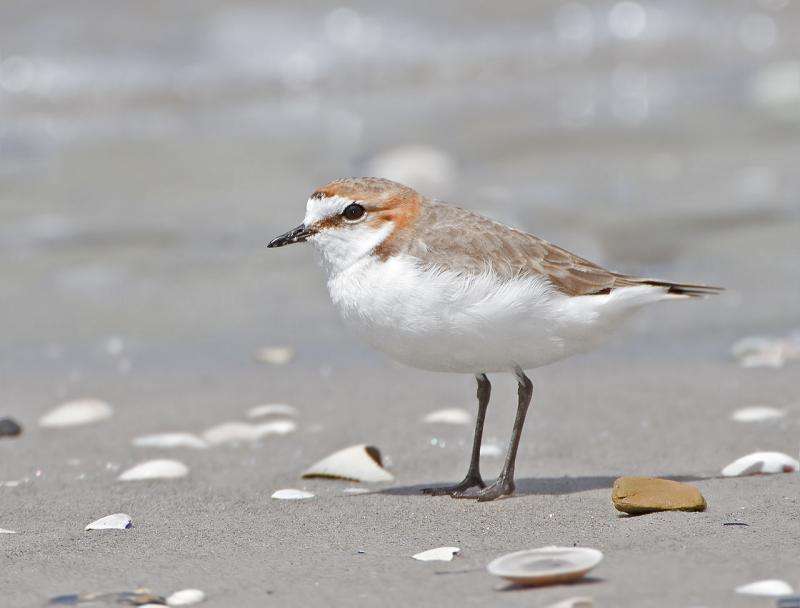April 8, 2015 report
Being more colorful found to be disadvantage for female plover

(Phys.org)—A team of researchers working in Australia has found that bright coloring on female birds appears to be a reproductive disadvantage. In their paper published in Proceedings of the Royal Society B, the team describes how they tested predation of red-capped plover eggs and discovered that enhanced coloring by the parent tending the nest, made the eggs a more likely target, at least during the day.
In many bird species, males sport bright colors and sometimes long feathers, as part of attracting a female. Meanwhile, females of the same species tend to be much more sedate in coloring. Red-capped plovers are one such example, the red cap on the head of males is bright red, while on the female its light brown. The researchers wondered if the female coloring was subdued due to reasons other than it simply being unnecessary.
To find out, they set up a test environment consisting of models of plovers sitting next to a clutch of eggs—they used pheasant eggs instead of plovers—they look the same. They then taped ravens as they swooped down and grabbed some of the eggs. They varied the models, sometimes using red capping to mimic males, other times brown to mimic females. They also conducted their study when it was dark out, when it is foxes that are after the eggs. Plover parents take turns sitting on the nest—the females take the day shift while the males are on at night.
In analyzing the video, the researchers discovered that ravens were far more likely to grab some eggs during daylight hours if a male with its red cap was guarding the eggs (80 percent of those on display were taken by ravens) versus the females (only 20 percent the eggs were taken)—at night, the red markings made no difference because foxes find eggs using their nose—the predators ran off with 80 percent of those set out.
The researchers claim their findings indicate that the female birds have clearly evolved in ways that make them less noticeable to predators, and thus their eggs are more difficult to find than if they had coloring similar to their male mates.
More information: The bright incubate at night: sexual dichromatism and adaptive incubation division in an open-nesting shorebird, Proceedings of the Royal Society B, rspb.royalsocietypublishing.or … .1098/rspb.2014.3026
Abstract
Ornamentation of parents poses a high risk for offspring because it reduces cryptic nest defence. Over a century ago, Wallace proposed that sexual dichromatism enhances crypsis of open-nesting females although subsequent studies found that dichromatism per se is not necessarily adaptive. We tested whether reduced female ornamentation in a sexually dichromatic species reduces the risk of clutch depredation and leads to adaptive parental roles in the redcapped plover Charadrius ruficapillus, a species with biparental incubation. Males had significantly brighter and redder head coloration than females. During daytime, when visually foraging predators are active, colour-matched model males incurred a higher risk of clutch depredation than females, whereas at night there was no difference in depredation risk between sexes. In turn, red-capped plovers maintained a strongly diurnal/nocturnal division of parental care during incubation with males attending the nest largely at night when visual predators were inactive and females incubating during the day. We found support for Wallace's conclusion that reduced female ornamentation provides a selective advantage when reproductive success is threatened by visually foraging predators. We conclude that predators may alter their prey's parental care patterns and therefore may affect parental cooperation during care.
Journal information: Proceedings of the Royal Society B
© 2015 Phys.org




















